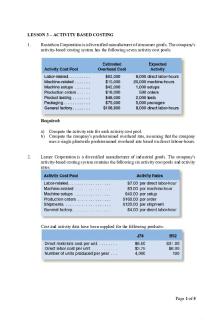Lab1rp - abc PDF

| Title | Lab1rp - abc |
|---|---|
| Author | Tran Nguyen |
| Course | Organic Chemistry (2nd Sem) |
| Institution | Golden West College |
| Pages | 3 |
| File Size | 98.2 KB |
| File Type | |
| Total Downloads | 59 |
| Total Views | 142 |
Summary
abc...
Description
Tran Nguyen CHEM 225 Prof. Khong Partner: Julio Gonzalez Experiment #1: Column Chromatography and UV/Visible Spectroscopy Calculations
Conclusion - It is obvious that Column chromatography did a really great job at separating the carotenes from other pigments, because the TLC plate has shown that there are no other pigments (besides carotenes) visible on the yellow band. - Compared to groups with other vegetables, some of them also have an efficient separation of carotenes, while some still have another blurry spot on their yellow band, according to their TLC plates. However, the yellow colors of their TLC plates are all positioned at the same spot (on the very top). - The column chromatography may have produced slightly different results because of the techniques used, contamination, or small mistakes students made during the experiment. However, all the vegetables produce pigments with similar absorbance values according to the observations made during lab, despite that the wavelengths are a little different.
Post-lab Questions 1. For a better separation, the spot should be concentrated in a small area, so adding as little solvent as possible would result a small width of colored (green/yellow) bands. 2. As we are using petroleum ether, which is mostly non-polar structured, to run the column chromatography, the yellow band (carotene), which is also mostly non-polar structured, would elute earlier before the green band (chlorophylls), which are mostly polar. 3.
References Klein, David R. Organic Chemistry. 3rd Ed. Johns Hopkins University, 2017. Mohrig, Jerry J. Laboratory Techniques in Organic Chemistry, 4th Ed. Freeman, 2014. Speakman, Teresa J. Chemistry 225 Laboratory Manual, Golden West College, 2018....
Similar Free PDFs

Lab1rp - abc
- 3 Pages

L3 ABC - ABC Questions
- 5 Pages

Orosz - abc
- 169 Pages

ABC samenvatting
- 15 Pages

Abc - hhjh
- 2 Pages

Lab7rp - abc
- 3 Pages

ABC questions
- 26 Pages

ABC methode
- 7 Pages

4 - abc
- 2 Pages

ABC chart
- 7 Pages

Swing - ABC
- 2 Pages
Popular Institutions
- Tinajero National High School - Annex
- Politeknik Caltex Riau
- Yokohama City University
- SGT University
- University of Al-Qadisiyah
- Divine Word College of Vigan
- Techniek College Rotterdam
- Universidade de Santiago
- Universiti Teknologi MARA Cawangan Johor Kampus Pasir Gudang
- Poltekkes Kemenkes Yogyakarta
- Baguio City National High School
- Colegio san marcos
- preparatoria uno
- Centro de Bachillerato Tecnológico Industrial y de Servicios No. 107
- Dalian Maritime University
- Quang Trung Secondary School
- Colegio Tecnológico en Informática
- Corporación Regional de Educación Superior
- Grupo CEDVA
- Dar Al Uloom University
- Centro de Estudios Preuniversitarios de la Universidad Nacional de Ingeniería
- 上智大学
- Aakash International School, Nuna Majara
- San Felipe Neri Catholic School
- Kang Chiao International School - New Taipei City
- Misamis Occidental National High School
- Institución Educativa Escuela Normal Juan Ladrilleros
- Kolehiyo ng Pantukan
- Batanes State College
- Instituto Continental
- Sekolah Menengah Kejuruan Kesehatan Kaltara (Tarakan)
- Colegio de La Inmaculada Concepcion - Cebu




